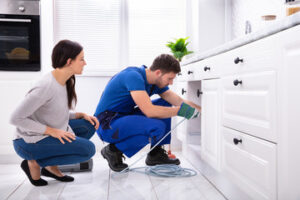Richmond VA Kitchen Remodeling can improve the overall look of a home and offer greater functionality. It can be a minor remodel that makes surface-level changes or a major remodel that involves reconfiguring the layout and upgrading to newer, more energy-efficient appliances.
During the planning phase, homeowners set goals for what kind of change they want to see in their kitchen. Some of the most common goals include:

A kitchen remodeling project is a major undertaking that requires time and money. It’s a great way to improve the look and feel of your home and increase its value. Upgrading your appliances is an important step during a remodel. If your appliances are older and outdated, they may not be as energy efficient as newer models. Upgrading to energy efficient appliances will help you save money on your utility bills while also improving the overall function of your kitchen.
Newer models offer a variety of design styles and colors to choose from. They are available in stainless steel, a wide range of bright colors and even classic neutrals to suit any style. You can also choose to incorporate smart technology into your appliances, like a refrigerator with an app that will tell you when you’re running low on milk or eggs. These newer features are sure to please any prospective home buyers if you decide to sell your home in the future.
Upgrading your refrigerator is an excellent place to start during a kitchen remodeling project. It is the workhorse of your kitchen and gets opened several times a day, so it will take on lots of wear and tear over the years. Choose a model that is durable and easy to clean, with plenty of space for food and drinks. When shopping for appliances, be sure to have the exact dimensions of your kitchen and speak with a professional to ensure that the new appliance will fit properly.
You can also upgrade your dishwasher, stove and oven during a kitchen remodel to boost efficiency. Upgrading to a newer energy efficient model will help reduce your electricity usage while adding extra features that will make cooking for a large group of people more convenient.
Kitchen remodeling is an excellent way to transform your home and make it more enjoyable for you and your family. It’s also a great way to increase the resale value of your property and make it easier for potential home buyers to picture themselves living in the space.
More Storage
A kitchen is where food is prepared and eaten, but it’s also often a gathering place for family and friends. A well-designed kitchen can bring more function to this space, making it easier to work in and more attractive to guests. Replacing old cabinetry, rejiggering the flow of counters and appliances and adding new storage solutions can help you make better use of your space.
One of the biggest benefits of remodeling your kitchen is that it will add value to your home. A modern, beautiful kitchen will impress buyers and may make the difference between a sale and no sale.
Whether you’re looking for a new place to store your Deviled Egg platters or a better way to organize your pots and pans, the right storage solution can save you time and headaches. Mounting shelves on unused walls or in the corners of cabinets can free up floor space for other items, while adding extra drawers and pantry space to accommodate oversized cookware, dishes and cook books can make your kitchen more functional and organized.
Kitchen remodeling also provides an opportunity to upgrade your kitchen’s safety features. For example, older homes typically don’t have GFCI electrical outlets, but installing them during a remodel will improve your kitchen’s overall safety. Also, replacing older appliances with more energy-efficient models will reduce your utility bills.
Before you get out the sledgehammer and reciprocating saw, make sure your contractor has clearly defined what’s involved in your project’s scope. This includes determining which walls are load bearing and which can be removed. Moving plumbing pipes and reconfiguring the kitchen layout will add cost and lead time to your project.
Many professionals divide kitchen redos into categories called minor and major, with minor being cosmetic changes and major involving structural modifications. Minor updates might include a fresh coat of paint, new flooring or an upgraded countertop. Major renovations involve tearing down walls and changing the floor plan, which can require permits and can be disruptive to your daily life while construction is underway. This type of project is typically the most expensive, but it can be the most rewarding.
Contemporary Style
As the name suggests, contemporary design blends elements from several styles and trends. The result is a kitchen that feels current, while still providing functionality and elegance. This versatility makes it an ideal choice for your home renovation project.
Both contemporary and modern designs feature sleek lines that evoke a sense of refinement. They also feature open spaces that merge the kitchen with dining or living areas, creating an airy and comfortable environment for cooking and entertaining. In addition, both styles avoid ornate details and heavy elements that can overwhelm a room.
Modern kitchens typically incorporate characteristics from several historic design movements, including Art Deco, Mid-Century Modern, and Modernism. The distinction between the two is a bit blurred, but knowing which features belong to each style can help you make better choices when choosing materials and finishes for your kitchen remodeling project.
Whether your new kitchen is a contemporary, traditional or transitional design, you will want to focus on the clean lines of the space, as well as the use of light colors and neutral shades to give the room a fresh appearance. Neutral colors also provide a flexible backdrop that can be accented with a few vibrantly colored items to create visual interest.
Minimalist fixtures and appliances offer a cohesive look that is both simple and sophisticated. Choose light-colored countertops and backsplashes to reflect the natural light in the room and keep it feeling airy. You may also want to include a wood-burning stove or an island with a gas range for added warmth and character.
For contemporary homes, open concept layouts are often favored as they create a spacious and inviting environment. The use of neutral colors is also common, with the occasional bright pop of color to add a sense of excitement and energy.
Unlike some other design styles, contemporary isn’t overly reliant on ornate details, so you don’t have to worry about finding items that match the style perfectly. However, you should be mindful of the scale and placement of furniture and accessories as they must be appropriate for the size of the room to remain visually balanced.
Energy-Efficient
Choosing energy-efficient appliances and materials during your kitchen remodel can save you money on utility bills. It can also reduce your carbon footprint and contribute to a greener world. A reputable kitchen remodeler will work with you to create a custom design that optimizes your space, taking into account how much light and heat it receives. They can incorporate skylights, large windows, and smart power strips to minimize phantom power consumption. They can also install LED bulbs that use less energy, emit less heat, and last longer than traditional bulbs. They can also place lighting on dimmers to set the mood and control energy usage. They can also maximize natural light by installing new windows, removing things that block sunlight, and using light-colored walls and ceilings. ENERGY STAR-certified appliances can be another great option for saving on your energy bill, since they’re tested for performance, quality, and efficiency.
Eco-friendly features can add value to your home by making it more appealing to potential buyers. Many homebuyers prioritize sustainability and energy-efficiency in their property selection, so including eco-friendly options during your kitchen remodeling can speed up the sale process. It can also help you qualify for tax deductions or rebates.
You can also increase the eco-friendliness of your kitchen by adding better insulation and addressing any duct or air sealing needs. This will keep your kitchen cozy in winter and cool in summer, while reducing the load on your heating and cooling systems. It can also help you avoid wasting energy by adjusting the temperature in your kitchen when it’s not being used.
Other eco-friendly options that you can implement include using reusable cookware and cutlery, incorporating recycled materials into your cabinets and countertops, and promoting proper ventilation. This will help you reduce your household’s carbon footprint while still maintaining a functional and stylish kitchen. In addition, you can opt for renewable energy sources, such as solar panels and wind turbines, to further decrease your reliance on the energy grid. You can even take a big step toward a greener future by recycling your old appliances, which will not only reduce your impact on the environment but also help the planet.



